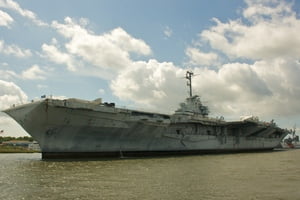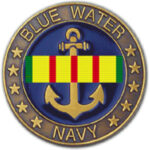The U.S. Navy fleet consists of a wide variety of ship types. Each type has a function and a classification. There are four basic levels to U.S. Navy ship classifications. Ships are divided into two categories: combat and support. Combat ships are then broken down into two classifications: warships and other combatants. These classifications are further divided into types. Within these types, if necessary, vessels are further broken down into subtypes, based upon very specific characteristics.
For example, an amphibious assault ship (LHA) falls under the combat category, is classified as “other combatant,” is of the amphibious warfare ship type, and is part of the amphibious helicopter and landing craft carrier sub-type.
The following list reflects the 10 primary types of U.S. Navy ships currently in operation.
Aircraft Carrier Type
Category: Combat
Classification: Warship
The aircraft carrier type consists of all ships designed for the primary purpose of conducting air-combat operations against airborne, surface, sub-surface and shore targets. The aircraft carrier provides a mobile platform that is capable of delivering military air power around the world.
Surface Combatant Type
Category: Combat
Classification: Warship
The surface combatant type consists of large, heavily armed, surface ships that are designed primarily to engage enemy forces on the open seas, as well as strike inland, coastal targets. They provide offensive and defensive, multi-mission capabilities, either independently or as part of a larger task force. Examples of sub-types include battleships, cruisers, destroyers and frigates.
Submarines Type
Category: Combat
Classification: Warship
The submarine type consists of all vessels capable of underwater operations. These types of vessels are self-propelled and can function in research, rescue and/or combat roles. Examples of sub-types include attack subs, guided missile subs and ballistic missile subs.
Patrol Combatant Type
Category: Combat
Classification: Other Combatant
The patrol combatant type consists of coastal patrol vessels that possess the capability to operate outside of coastal waters, on the open seas, for at least 48 hours without support.
Amphibious Warfare Type
Category: Combat
Classification: Other Combatant
The amphibious warfare ships feature a capability for amphibious assault and possess design characteristics enabling extended operations on the open seas. Examples of this type include amphibious assault ships and landing craft carriers.
Combat Logistics Type
Category: Combat
Classification: Other Combatant
The combat logistics ships have the capability to provide replenishment to fleet units while underway. Examples of this type include ammunition ships, combat store ships, oilers, fast combat support ships and replenishment oilers.
Mine Warfare Type
Category: Combat
Classification: Other Combatant
The mine warfare ship engages in laying, detecting or removing mines. Examples of this type include minesweepers and mine countermeasure ships.
Coastal Defense Type
Category: Combat
Classification: Other Combatant
Coastal defense ships consist of coastal patrol vessels that do not possess the capability to operate outside of coastal waters for at least 48 hours without support. They typically patrol harbors, inter-coastal waterways or rivers.
Auxiliary Type
Category: Combat
Classification: Other Combatant
The auxiliary ship provides general support to either other fleet vessels or shore-based facilities. These ships have the capability to operate in the open ocean for extended periods of time.
Support Craft Type
Category: Support
The support craft classification consists of commercial, non-military ships that are operated by the Navy in a military capacity. As such, they are always non-combat rated ships. Their function is to provide general support to either other fleet ships or shore-based facilities. These are noncombat ships such as dry docks, tugs, barges, tankers, lighters and other miscellaneous ships.
Sources:
“U.S. Navy Ships,” United States Navy
“Current US Navy Ship Classifications,” Naval Vessel Register
“World Navies Today: United States of America,” Haze Gray & Underway




